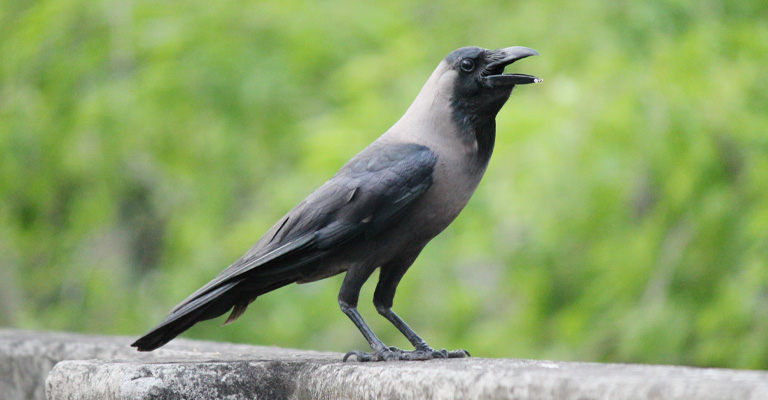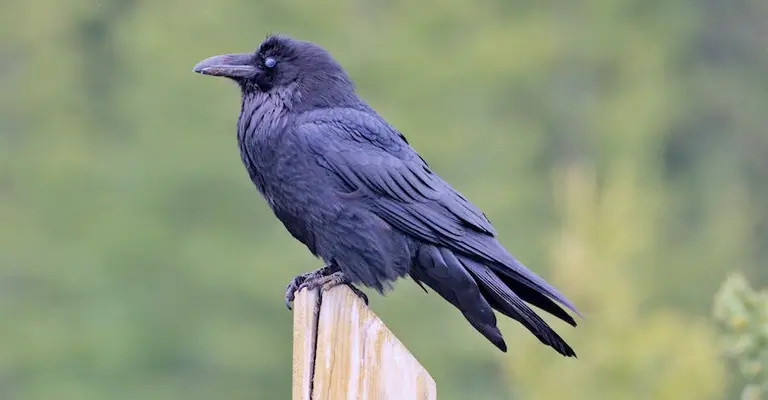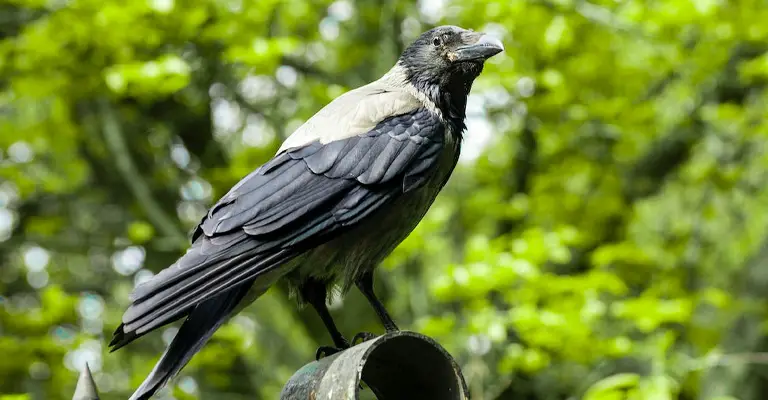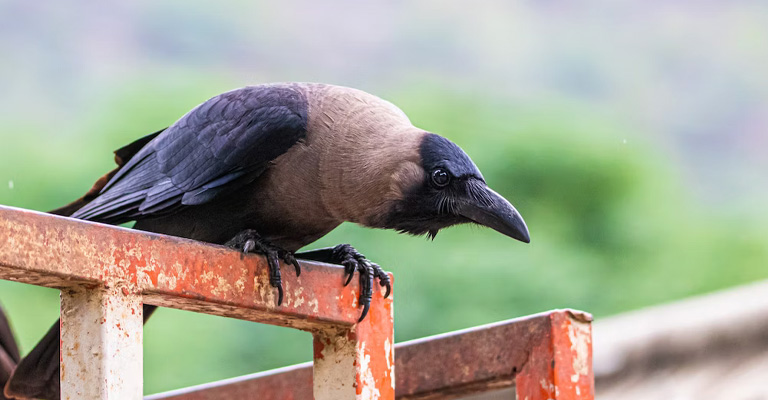Crows, with their intriguing behaviors and vocalizations, have captivated human curiosity for centuries. Their ability to communicate, recognize faces, and exhibit intelligence sets them apart from many other avian species.
The peculiar and sometimes weird noises they produce raise questions about their motivations and meanings. And that makes many of us curious about them. That’s the same reason many of you ask why is this crow making a weird noise.
This article explores the reasons behind crow’s strange vocalizations, shedding light on their fascinating behavior. If you are confused about this fact and want to know the reason, check the details till the end.

The Vocalizations of Crows
Crows are highly vocal birds, utilizing a wide range of vocalizations to communicate with each other and convey different messages.
Their vocal repertoire is remarkably diverse, consisting of calls, caws, coos, rattles, and even mimicry of other sounds.
Each of these vocalizations serves a specific purpose and conveys unique information within the crow community.
When it comes to calls, crows have a variety of distinct vocalizations. They have alarm calls, which are sharp, loud caws that indicate a potential threat or danger in the vicinity.
These calls serve to alert other crows and prompt a coordinated response. Crows also have territorial defense calls, which are aggressive and forceful, used to establish and protect their territories from intruders.
In addition to calls, crows engage in more melodic vocalizations. They may sing together, creating a harmonious chorus, particularly during courtship or social bonding.
Crows also emit cooing sounds, which are softer and more intimate vocalizations used for communication within close-knit groups or between individuals.
Furthermore, crows exhibit rattling vocalizations, characterized by rapid and repetitive sounds. These rattles often accompany intense interactions, such as mobbing behavior, where multiple crows gather and vocalize collectively to defend against a common enemy.
Lastly, crows are renowned for their ability to mimic sounds, including those of other birds, animals, and even human speech, adding a fascinating dimension to their vocal abilities.
Importance of Vocal Communication Among Crows

Vocal communication plays a crucial role in the social dynamics and survival of crow communities. Crows are highly social birds, forming complex family groups and extended social networks.
Their vocalizations serve as a means of conveying information, expressing emotions, and coordinating group activities.
One of the primary functions of crow vocalizations is to transmit warnings and alerts. Alarm calls, with their piercing and distinctive caws, quickly communicate potential threats to other members of the crew group.
This allows for rapid mobilization and collective defense against predators or intruders.
Vocalizations also facilitate social bonding and cooperation among crows. Singing together and engaging in coordinated vocal displays strengthen social ties within the group, establish hierarchies, and potentially attract mates during the breeding season.
Cooing sounds are particularly important for maintaining social cohesion within smaller, closely-knit groups of crows.
Furthermore, vocal communication enables crows to establish and defend their territories. Territorial defense calls, characterized by their assertive and aggressive nature, serve as vocal markers, proclaiming ownership and warning rival crows to stay away.
These territorial boundaries help maintain access to resources and ensure the survival of the group.
The vocalizations of crows are essential for their social interactions, group cohesion, and survival. Through their diverse range of vocalizations, crows effectively convey information, coordinate activities, and maintain social bonds within their communities.
Understanding these vocalizations provides valuable insights into the complex and intelligent nature of these remarkable birds.
Possible Reasons for Weird Crow Noises

Crows are known for their diverse vocalizations, but sometimes they may produce unusual or weird noises that capture our attention. These peculiar sounds can stem from various reasons, including:
Alarm or Distress Calls
One possible reason for weird crow noises is the presence of a perceived threat or danger. Crows have distinct alarm calls that they use to alert other members of their group about potential hazards in their environment.
These alarm calls are often loud, sharp, and intense, serving as a warning signal to others. A weird crow noise could be an altered or modified version of their typical alarm call, indicating a heightened state of alarm or distress.
Communication Within the Crow Community

Crows are highly social birds that rely on vocal communication to interact with each other. Weird crow noises could be a form of communication specific to their community.
Just as humans have slang or unique vocal expressions within their social groups, crows may have their own variations of vocalizations that are understood by their peers.
These unconventional noises may convey specific messages or serve a social bonding purpose within the crow community.
Vocalization Variations
Crows have a remarkable vocal repertoire, and they can produce a wide range of sounds beyond their standard calls. Vocalization variations can occur due to individual differences or unique expressions of a specific crow.
Similar to humans having different accents or vocal quirks, crows may have their own vocal peculiarities that result in weird noises. These variations can reflect the individuality and diversity present among crows.
Mimicry of Other Species or Sounds
Crows are renowned for their ability to mimic various sounds, including those of other animals, birds, or even human-made noises. If a crow is making a weird noise, it might be imitating the vocalizations it has heard from its environment.
It could be mimicking sounds of other bird species, mechanical sounds, or even human voices. Mimicry is a way for crows to exhibit their intelligence and adaptability.
Influence of Environmental Factors
Environmental factors can also influence the vocal behavior of crows, leading to unusual or weird noises. Changes in weather conditions, the presence of predators, or disturbances in their habitat can elicit unique vocal responses from crows.
They might express their excitement, frustration, or anxiety through unconventional vocalizations, adapting their communication to suit the circumstances.
These are the possible reasons for crows to make weird noises. But this is not all. There can be other reasons that bother them to make weird noises as well.
Understanding Crow Behavior
To understand the behavior of crows, you need to know about a few factors well. I have listed them right below with a brief explanation. I hope you won’t skip anything.
Intelligence and Social Nature of Crows
Crows are renowned for their exceptional intelligence. They possess problem-solving skills, demonstrate tool use, and exhibit advanced cognitive abilities.
Research has shown that crows can solve complex puzzles, remember specific locations of food caches, and even use tools to obtain food. Their intelligence is comparable to that of some primates, showcasing their adaptability and ability to thrive in various environments.
Crows are also highly social creatures. They form tight-knit family groups and engage in cooperative behaviors. They exhibit complex social structures, with hierarchies and distinct roles within their communities.
Crows communicate and cooperate with each other to defend territories, find food, and raise their young. Their social interactions demonstrate a level of sophistication and understanding within their groups.
Recognition of Individuals and Faces
One fascinating aspect of crow behavior is their ability to recognize and remember individuals, including human faces. Research has shown that crows can distinguish between different people and remember them for years.
They not only recognize faces but also associate specific individuals with certain behaviors or experiences. This recognition extends to their own species as well, allowing them to identify familiar and unfamiliar crows within their social networks.
This remarkable capability to recognize faces plays a crucial role in crow behavior. It helps them assess threats and identify friendly individuals.
Crows can communicate information about potential dangers or safe individuals to other members of their group, contributing to their collective survival.
Playfulness and Attraction to Shiny Objects
Crows are known for their playful behavior, which is evident in their interactions with each other and their environment. They engage in games, aerial acrobatics, and engage in playful chases.
Play serves several purposes for crows, including social bonding, skill development, and mental stimulation.
Another intriguing aspect of crow behavior is their fascination with shiny objects. They are attracted to items that sparkle, such as pieces of jewelry, coins, or other reflective materials.
This attraction to shiny objects may be driven by their innate curiosity and the visual appeal these items hold. Crows have been observed collecting and hoarding shiny objects in their nests, suggesting a unique aesthetic preference.
The playfulness and attraction to shiny objects highlight the complex and diverse behaviors exhibited by crows. It showcases their curiosity, adaptability, and capacity for individual preferences and interests.
Understanding the intelligence, social nature, recognition abilities, playfulness, and attraction to shiny objects in crows provides insights into their rich behavioral repertoire.
It underscores the complexity of these remarkable birds and their fascinating interactions with their surroundings.
Observing the Crow’s Behavior
You can’t simply observe the behavior of a crow by looking at it all day long. Indeed, you need to look over a few factors that belong. You’ll understand them all by following the below points.
Importance of Careful Observation
When trying to understand the behavior of crows, careful observation is key. Crows are intelligent and complex creatures, and their behaviors can provide valuable insights into their social dynamics and individual characteristics.
By closely observing their actions, vocalizations, and interactions, we can gain a deeper understanding of their world and the reasons behind their weird noises.
Paying Attention to Context and Triggers
To decipher the meaning behind a crow’s weird noise, it is crucial to pay attention to the context in which it occurs and any potential triggers.
Note the time of day, the presence of other birds or animals, and any specific environmental factors that might influence the crow’s behavior.
By identifying patterns or correlations, we can uncover possible explanations for unusual vocalizations.
Documenting Behavior for Better Understanding
Documenting the behavior of crows can be immensely helpful in unraveling the mysteries of their weird noises. Keep a journal or take notes of observations, including the date, time, location, and specific behaviors exhibited by the crows.
Capture the sounds they make, their interactions with other crows or their surroundings, and any notable events that coincide with the weird noises.
This documentation will aid in forming a comprehensive picture and may provide insights when analyzing the data at a later stage.
Photographs or videos can also be valuable tools for capturing and studying crow behavior. Visual evidence can help in identifying individual crows, understanding their body language, and documenting any unique or peculiar behaviors they exhibit.
By carefully observing, noting, and documenting the behavior of crows, we can contribute to a better understanding of their vocalizations and overall behavior.
This process allows us to delve deeper into the complexities of their world and gain a greater appreciation for these remarkable and enigmatic birds.
FAQs
Crows gather in large groups, known as murderers, for various reasons. They benefit from safety in numbers, as more crows can help detect and deter predators.
Grouping also facilitates cooperative foraging, sharing of information, and social interactions within the crow community.
Yes, crows are highly intelligent and have been observed demonstrating remarkable problem-solving skills. They can use tools, such as sticks or wires, to obtain food from hard-to-reach places.
Crows have also shown the ability to devise innovative solutions to overcome obstacles and obtain rewards.
While self-recognition in a mirror is typically associated with certain primates and a few other animals, crows have not been specifically tested for this ability.
However, crows do display self-awareness, as they can recognize and remember their own reflections on glass surfaces, suggesting a level of self-recognition.
There have been observations suggesting that crows may engage in mourning behavior. They have been seen gathering around the body of a deceased crow, displaying quiet and solemn behavior.
This behavior may serve as a way to pay respects or acknowledge the loss within their social group.
Crows have an impressive ability to remember and recognize faces. Studies have shown that they can remember human faces for several years, and they can also distinguish between familiar and unfamiliar crows based on facial features.
This long-term facial recognition helps crows in assessing threats and establishing social relationships.
Wrapping Up
Crows’ weird noises can be attributed to various factors such as alarm calls, unique communication within their community, vocalization variations, mimicry, and environmental influences.
Understanding their behavior requires careful observation, considering context and triggers, and documenting their actions.
Unraveling the mysteries of crow vocalizations offers valuable insights into their intelligence, social nature, and adaptability.
However, after this long discussion, I can now anticipate that you have understood the fact well. You can knock me in the comment section if you have any further confusion. Thank you.